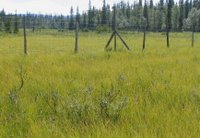Saturday, August 12, 2006
Kenkäheinää kerrakseen
 Kun Etelä- ja Länsi-Suomessa tuskaillaan kesän kuivuutta ja huonoja (karjatalouden) heinäsatoja, Itä-Lapissa, ainakin Värriön kairassa kasvaa paitsi puu myös heinä. Tämän vuoden kenkäheinäsadosta näyttää tulevan aivan mukiinmenevä.
Kun Etelä- ja Länsi-Suomessa tuskaillaan kesän kuivuutta ja huonoja (karjatalouden) heinäsatoja, Itä-Lapissa, ainakin Värriön kairassa kasvaa paitsi puu myös heinä. Tämän vuoden kenkäheinäsadosta näyttää tulevan aivan mukiinmenevä.Itse asiassa kenkäheinä ei ole heinä vaan sara. Kenkäheinäksi korjattiin yleisimmin pullosaraa (Carex rostrata, ks. myös Luontopäiväkirjan merkintä tasan vuosi sitten, 12.8.2005). Tälläkin Värriön luonnonpuiston länsiosan aapasuolla kenkäheinää olisi korjattavaksi moneksi sukkapariksi. Kuvan poroaita erottaa Sallan pohjoisen ja Kemi-Sompion paliskunnat toisistaan.
 Kun kenkäheinälaihoa ei vuosittain korjata, siihen pääsee rikkakasviksi sekaan pohjanpajua (Salix lapponum). Mutta eihän luonnonpuistosta voi korjata kenkäheinää sen enempää kuin puutakaan, joten pohjanpaju saa rauhassa kasvaa. Eipä kenkäheinällä tosin olisi nykyään enää menekkiäkään.
Kun kenkäheinälaihoa ei vuosittain korjata, siihen pääsee rikkakasviksi sekaan pohjanpajua (Salix lapponum). Mutta eihän luonnonpuistosta voi korjata kenkäheinää sen enempää kuin puutakaan, joten pohjanpaju saa rauhassa kasvaa. Eipä kenkäheinällä tosin olisi nykyään enää menekkiäkään.There has been a record drought in Southern and Western Finland in summer 2006. Subsequently, hay (fodder) yields have been low. This year Eastern Lapland is more lucky, especially if it the question about "Shoe grass". In oldern times the local saami people used to prepare it for winter shoes (before the era of socks). Shoe grass was harvested, dried and processed out of Bottle sedge (Cares rostrata). At least this aapa mire in the western part of Varrio Nature reserve would have given good yield.
From plant husbandry point of view there seem to be some weeds (Salix lapponum) inside the Carex crop. Of course we cannot tend such fields or harvest anything in strict nature reserve like Varrio. But it does not matter: to be honest with shoe grass markets today, they do not exist any more.